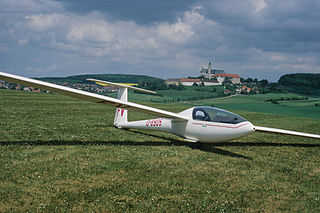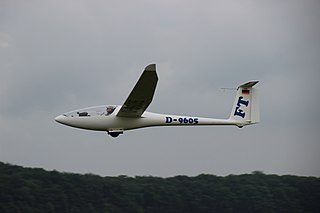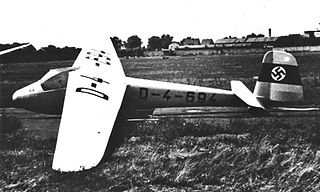Related Research Articles

The Akaflieg Stuttgart fs24, nicknamed Phönix, was a glider designed and built in West Germany from 1951.

The SZD-59 Acro is a single-seat glass composite glider for aerobatics and cross-country flying by PZL Allstar of Bielsko-Biala, Poland.
The Akaflieg Stuttgart fs16, nicknamed Wippsterz was a glider aircraft that was designed and built in Germany from 1936. Only one example of the design was constructed.
The Akaflieg Stuttgart fs17 was a glider aircraft that was designed and built in Germany from 1936. It notably featured a prone seating position for its pilot.
The Akaflieg Stuttgart fs18a was a glider designed and built in Germany from 1938. It was characterized by a gull wing and was the first glider to have a retractable undercarriage. Only one example of the design was constructed.

The Akaflieg Berlin B12 is a high performance two-place glider aircraft that was designed and built in Germany. Conceived as a research vehicle, only one unit was constructed.

The Akaflieg Berlin B13 is a two-seat motor-glider designed and built in Germany.

The Akaflieg Stuttgart fs26 Moseppl is a German single-seat motor glider with twin fins and rudders designed and built by Akaflieg Stuttgart. First flown on the 25 September 1970 it was designed as an experiment and not intended for production.
The Akaflieg Braunschweig SB-11 is an experimental, single seat, variable geometry sailplane designed by aeronautical students in Germany. It won the 15 m span class at the World Gliding Championships of 1978 but its advances over the best, more conventional, opposition were not sufficient to lead to widespread imitation.

The Akaflieg Stuttgart fs31 Ferdinand Porsche is a tandem seat, dual control training glider designed and built in Germany between 1977 and 1981. The aircraft was intended to have high performance, yet to be robust enough for student use. It was not intended for production and remains in service with the Akaflieg after almost 40 years and 7,100 flying hours.
The Akaflieg Braunschweig SB-8 is an experimental, single-seat, high performance glider built in Germany in the 1960s, constructed largely from glass fibre skin over built up balsa wood structure. Two were built; the second of which was later fitted with a high aspect ratio (30:1) wing, becoming the Akaflieg Braunschweig SB-9 Stratus.
The Akaflieg Stuttgart fs28, nicknamed Avispa is a single engine, twin boom pusher configuration light sports and utility aircraft designed at the University of Stuttgart in West Germany in the 1970s. Unusually, it has an inverted V-tail. The sole example remained active as of 2010.
The Akaflieg Braunschweig SB-6 Nixope was an early (1961) GRP high performance single seat glider designed and built in Germany by aeronautical students from Brunswick University. It competed in the 1961 German National gliding competition, coming sixth, and led directly to two further GRP aircraft.

The AK-5 is a single-seat club class sailplane designed and built in Germany by members of Akaflieg Karlsruhe.

The Akaflieg Karlsruhe AK-5b is a single-seat club class glider designed and built in Germany by members of Akaflieg Karlsruhe.

The Akaflieg Berlin B5 was a glider built in Germany in the late 1930s. It featured a high-wing, cantilever sailplane configuration of all-wood construction, with cantilevered gull-wings, retractable landing-gear, all-moving-tail, dive air-brakes.

The Akaflieg Berlin B6 was a glider built in Germany in the late 1930s. It featured a high-wing, cantilevered mid-wing sailplane configuration with Junkers-flaps, retractable landing gear, all moving tail, dive air brakes, wood and steel body.

The Akaflieg Berlin B8 was a German sailplane built in the late 1930s for the 1939 Olympic games glider competition in Rome. It was a high-wing sailplane with a cantilever shoulder-wing, dive air-brakes and all wood construction.

The Akaflieg Braunschweig SB 14 is an 18 m (59 ft) Open-class sailplane designed and built in Germany in the early 2000s.

The Akaflieg Stuttgart fs33 Gavilán is a high-performance two-seater class sailplane designed and built by Akaflieg Stuttgart.
References
- ↑ "fs32 – Aguila – Akaflieg Stuttgart e.V". Akaflieg Stuttgart e.V. Retrieved 2020-02-17.
- ↑ "Akaflieg Stuttgart fs-32". all-aero.com. Retrieved 8 March 2019.